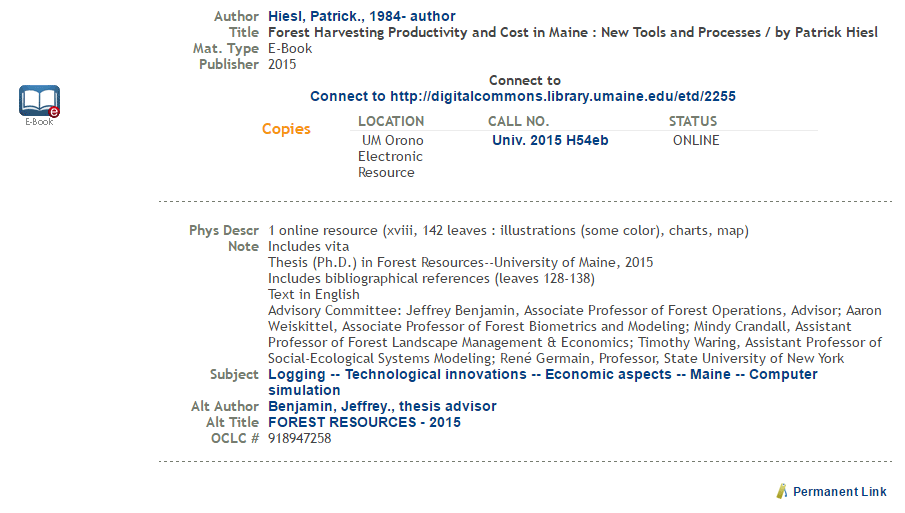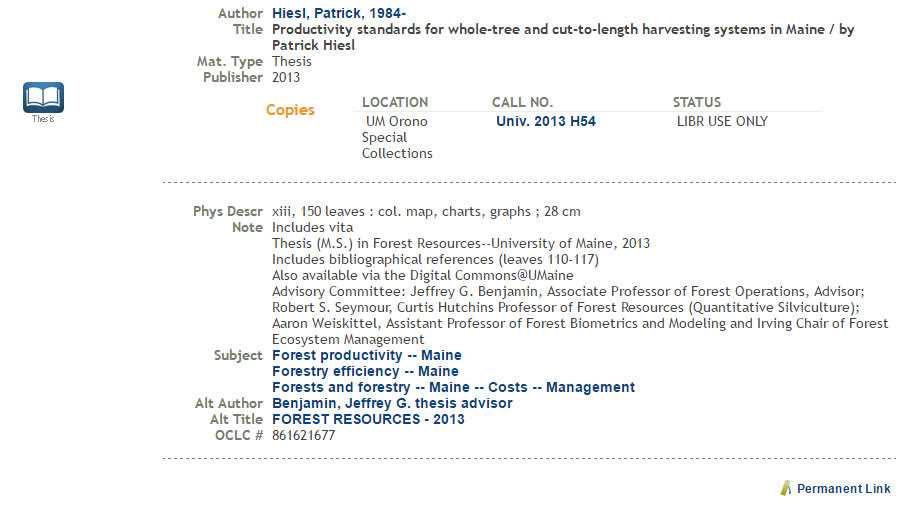Cataloging: Theses Submitted via Digital Commons
Purpose: As of the Fall 2015 semester all theses and dissertations will be uploaded by the author through Digital Commons. The workflow for Technical Services has changed to reflect the new submission process.
Prior to arrival in Cataloging:
- Theses and dissertations are uploaded by the author into Digital Common. The librarian is notified automatically that there is a new submission.
- The librarian reviews the submission for quality and adherence to established metadata practices that are documented in Digital Commons Metadata Entry Procedures.
- After review the thesis is uploaded to the Digital Commons and the link is sent to a cataloger for cataloging via OCLC’s Connexion interface.
In Cataloging:
-
- Print versions of theses ceased being sent to Special Collections archive after May 2016. When the occasional retrospective print thesis is ready to be cataloged first conduct a title search in URSUS.
- Open the Connexion Client and create a new book workform. To save keying, search for a recent UMaine thesis in Connexion, then use the old thesis as a template for the new one by going to Edit > Derive > New Master Record. (Note: When working in a derived record, you can uncontrol authorized fields by doing a right-click and selecting “uncontrol single.” Or using Edit >Control Headings > Uncontrol Single (F11)) Pay special attention to the following fields:
- Type: t (This type corresponds to “Manuscript Language Material.” It is used because theses are not considered to be formally published.)
- Form: o (This is the designation for online material)
- Desc: i (This is the designation for an RDA record)
- ELvl: I
- Cont: b, m (The first code indicates that a bibliography is present, which is true of virtually all theses. The second code indicates that the item in hand is a thesis.)
- Ills: a (illustrations) and b (maps) are the most commonly used codes.
- LitF: Generally 0 (nonfiction), but occasionally 1 (fiction) or some other value for creative writing theses
- DtSt: s
- Dates: Enter the thesis year in the first box and leave the second box blank.
- Lang: Generally eng (English) but occasionally fre (French).
- Ctry: xx (This code is used because a thesis is not considered to be formally published, so there is no subfield a in the 260 field.)
- 040: This field will need to have ‡e rda after the first institution code. This is automatically inserted if you have the “Use RDA workforms when creating a new record” checked. This is located under Tools>Options>RDA. NOTE: This subfield will not be added automatically if you derive a new master record.
- 043: This field is optionally used for theses whose topics cover a specific geographical area. Commonly used values are n-us-me (Maine) and n-us— (United States as a whole). Other values are also possible.
- 092: This field contains the local call number in the form Univ. [year] [LC Cutter] eb. E.g., Univ. 2011 F74. Use an LC Cutter table (such as the one at The Cataloging Calculator) to determine the two-digit call number based on the author’s surname, then search Millennium on the full call number to check the number is not a duplicate and that the author’s name files alphabetically with other theses authors. If this is not the case, adjust the Cutter number as necessary by changing or extending the digits.
- 100: Enter the name of the author, surname first. If the author supplies a year of birth in their vita, add it in the subfield ‡d. E.g., French, Lester A., ‡d 1966–. In RDA a relator term is needed as well, use ‡e author. Appendix I in RDA has a preliminary list of relators but it is not inclusive and institutions are allowed to create specific ones as needed. This will not prevent a name from validating, if they have a name authority record created, but it will not turn blue and underscore in Connexion. Example: 100 1_ ‡a French, Lester A., ‡d 1966- ‡e author.
- 245: Title and statement of responsibility in standard format. Because thesis titles often include words with unusual capitalization conventions (proper nouns, acronyms, genus and species names, etc.), it may be wise to consult the body of the thesis to ascertain correct sentence capitalization.
- 264: Omit the subfields ‡a and ‡b and put the date in ‡c. Example: 264 __ ‡c 2011.
- 300: Note that the pagination will be in leaves, not pages. In RDA abbreviations are no longer used, so spell out pages or leaves, and any parts of ‡b included in the thesis, and there is no period after the dimension, unless there is a 490 field as well. If the thesis includes extra media, such as a folded maps or a disc, add that information in a subfield ‡e. Example: 300 __ ‡a 1 online resource (pagination) : ‡b illustrations, map ; ‡c 28 cm
- 336: Content type is defined by the content presented. For theses this will almost always be text. Other content types are available and can be found on LC’s Term and Code List for RDA Content Types. Example: 336 __‡a text ‡b txt ‡2 rdacontent
- 337: Media Type is defined by the device required to interpret the content. For online theses it will always be computer. Other media types are available and can be found on LC’s Term and Code List for RDA Media Types. Example: 337__‡a computer ‡b c ‡2 rdamedia
- 338: Carrier type is defined by the storage medium for the content. For online theses it will always be online resource. Other content types are available and can be found on LC’s Term and Code List for RDA Carrier Types. Example: 338__‡a online resource ‡b cr ‡2 rdacarrier
- 500: Add a 500 note that reads Includes vita. Vita generally consists of brief biography at the very back of the thesis.
- 502: Add a thesis note in the form: Thesis (Ph.D.) in Educational Leadership–University of Maine, 2011. Substitute the appropriate degree name, department name, and year as necessary. (The word “Thesis” is used for both master’s level theses and doctoral dissertations.) Note the following unusual circumstances:
- For interdisciplinary dissertations, the note should take the form Thesis (Ph.D.) Interdisciplinary in Sensors–University of Maine, 2011.
- For theses in double degree programs (such as the joint M.S. in Marine Policy and M.S. in Marine Biology), the 502 note may be repeated for each degree.
- 504: Note that the bibliography pagination will be in leaves, not pages.
- 530: Also available via the Digital Commons@UMaine
- 590: Add a 590 note which includes the full advisory committee information. See (Field will export to URSUS, but not saved in the OCLC master record.)
- 6xx: Assign one or more subject headings as necessary. Subject heading assignment can be difficult when the cataloger is unfamiliar with the subject area of the thesis. Here are some tricks and tips:
- Do a search in URSUS or LC Classification Web on keywords from the title to see if they happen to be authorized Library of Congress Subject Headings (e.g. Wetlands).
- Thesis advisors often advise many students who are working in the same general subject area, so doing an URSUS search on the adviser’s name may return other theses on the same topic with usable subject headings.
- If a thesis is about a specific plant or animal and there is no heading established for the specific genus and species, work backwards up the taxonomy until you find an established heading. (i.e., if you cannot find the species, search for the genus. If you cannot find the genus, search for the family, etc.)
- Do a search in WorldCat on keywords from the title to find other works on the same topic which may have assigned subject headings.
- 700: Add a 700 note for the thesis advisor, followed by subfield ‡e advisor ‡4 ths. (If two or more members of the advisory committee are listed as co-advisors, include a 700 note for each one.) Do a search on the advisor’s name in the OCLC Authority File. If there is not an authorized form of the advisor’s name, do a search on the name in Millennium and use the most common form of the name. The ‡e is for a relator term. Appendix I in RDA has a preliminary list of relators but it is not inclusive and institutions are allowed to create specific ones as needed. Example: Smith, John. ‡e advisor ‡4 ths
- 793 0_: Add a 793 note which includes the department name and year in the caps. EDUCATIONAL LEADERSHIP – 2011. (Field will export to URSUS, but not saved in the OCLC master record.)
- Use the following 949 33 command line:*recs-b;ov-.o;b1-4;b2-o;b3-z;bn-oro;i-[barcode number]/ty-97/loc-oweb/sta-k/i2-m
- After exporting to URSUS, print a call number label. Note that the URSUS label printer will put the period after Univ. in the wrong place and it will have to be moved for every thesis call number label printed.
URSUS default label: Univ
.2011
F74Correct label formatting: Univ.
2011
F74 - Examples of thesis with two records: E-thesis, Print version
See Also:
Assigning Cutter Numbers for UMaine Theses
Return to Technical Services TOC


